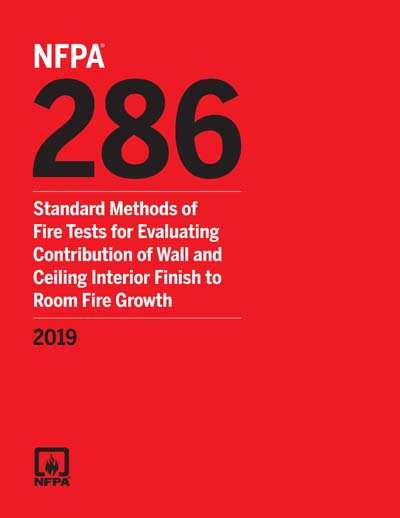Historical
NFPA 286-2019
NFPA 286 Standard Methods of Fire Tests for Evaluating Contribution of Wall and Ceiling Interior Finish to Room Fire Growth , 2019 edition
This standard describes a method for determining the contribution of interior finish materials to room fire growth during specified fire exposure conditions. This method is intended for the evaluation of the flammability characteristics of wall and ceiling interior finish, where such materials constitute the exposed interior surfaces of buildings. This fire test method is not intended for the evaluation of fire resistance of assemblies, nor is it intended for the evaluation of the effect of fires that originate within a wall assembly. This standard specifies three types of specimen mounting, depending on the application of the interior finish material, as follows: (1) Three walls (for interior finish to be used on walls only) (2) Three walls and the ceiling (for interior finish to be used on walls and ceilings) (3) The ceiling alone (for interior finish to be used on ceilings only) This method of test measures certain fire performance characteristics of interior finish materials in an enclosure under specified fire exposure conditions. This method of test determines the potential extent to which the interior finish materials contribute to fire growth in a room, including the heat and smoke released, the combustion products released, and the potential for fire spread beyond the room, under the particular conditions simulated. The method of test provides the following: (1) Extent of fire growth in the fire test room (2) Rate of heat release by the specimen (3) Total heat released by the specimen (4) Time to flashover in the fire test room if flashover occurs (5) Time to flame extension beyond the doorway of the fire test room if flame extension occurs (6) Total heat flux incident to the floor of the fire test room (7) Upper level gas temperature in the fire test room (8) Smoke obscuration, as determined in the exhaust duct (9) Production of carbon monoxide, as determined in the exhaust duct (10) Emissions of other combustion gases, as determined in the exhaust duct This method does not provide data that can be generalized to apply to rooms or spaces of different shapes, sizes, and ventilation. The performance observed in the test is based on the test conditions. If a test specimen is exposed to a different environment, as in an actual fire, the performance of the specimen can be different. The method of test does not provide the following: (1) Full information concerning toxicity of combustion gases (2) Fire resistance of wall–ceiling systems
National Fire Protection Association [nfpa]

